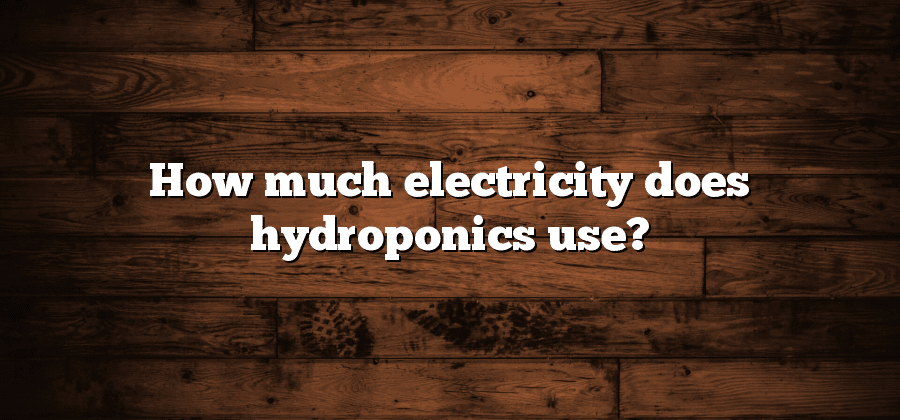Energy Consumption in Hydroponics: An Overview
Energy consumption is a critical aspect to consider in hydroponics, as it directly impacts the economic and environmental sustainability of the system. Hydroponic systems rely on various sources of energy, such as electricity for lighting and nutrient delivery, as well as heating and cooling systems to maintain optimal growing conditions. Understanding the factors that contribute to energy consumption in hydroponics is essential for growers to make informed decisions and implement strategies to minimize their energy usage.
One of the primary factors influencing energy consumption in hydroponic systems is the choice of lighting. Traditionally, high-intensity discharge (HID) lamps have been popular due to their high light output. However, these lamps are also known for their high energy consumption, resulting in increased operating costs. In recent years, light-emitting diode (LED) technology has gained popularity in the hydroponics industry. LEDs offer several advantages, including lower energy consumption, longer lifespan, and the ability to customize light spectra for specific plant requirements. Evaluating and comparing lighting options is, therefore, crucial to managing energy consumption effectively in hydroponic systems.
Factors Influencing Electricity Usage in Hydroponic Systems
Hydroponic systems require a significant amount of electricity to sustain optimal plant growth. Several factors influence the electricity usage in hydroponic systems, and understanding these factors is crucial for growers to maximize energy efficiency. One of the primary factors is the size and scale of the hydroponic operation. Larger systems that accommodate a larger number of plants naturally consume more electricity to power the necessary equipment, such as pumps and lights. Additionally, the complexity of the system plays a significant role in electricity usage. Advanced systems with sophisticated automation and monitoring equipment tend to draw more power than simpler setups.
The type of lighting used in a hydroponic system is another crucial factor influencing electricity usage. Traditional lighting options, such as high-pressure sodium (HPS) or metal halide (MH) lamps, have long been the industry standard. However, these lighting technologies are known for their high energy consumption and significant heat output. In recent years, light-emitting diode (LED) technology has gained popularity in the horticulture industry. LED lights offer several advantages, including energy efficiency, longer lifespan, and the ability to customize light spectra for specific plant needs. By utilizing LED lighting, growers can substantially reduce their energy consumption and subsequently lower their electricity costs.
Evaluating Lighting Options: LED vs. Traditional Lighting
Lighting is a critical component in hydroponic systems as it provides the necessary energy for photosynthesis to occur. When it comes to choosing the right lighting option, there are two main contenders: LED (Light Emitting Diode) and traditional lighting. LED lights have gained popularity in recent years due to their energy efficiency and long lifespan. They are designed to emit specific wavelengths of light, which can be tailored to the needs of different plant varieties. LED lights also have the advantage of producing less heat than traditional lighting, reducing the need for additional cooling systems. On the other hand, traditional lighting, such as fluorescent and high-pressure sodium lights, have been used in hydroponics for many years. These lights are known for their affordability and effectiveness. However, they tend to be less energy efficient and have a shorter lifespan compared to LED lights. Additionally, traditional lighting can generate significant amounts of heat, which can impact the overall temperature and humidity control in hydroponic systems. Ultimately, the choice between LED and traditional lighting will depend on various factors, including the specific crop, the available budget, and the desired energy efficiency. Careful consideration should be given to these factors in order to select the most appropriate lighting option for hydroponic systems.
The Impact of Nutrient Delivery Systems on Energy Consumption
Nutrient delivery systems play a crucial role in hydroponic systems, providing plants with the essential elements they need to grow. However, it is important to consider the impact of these systems on energy consumption. Different types of nutrient delivery systems have varying levels of energy requirements, which can significantly affect the overall efficiency of a hydroponic operation.
One common nutrient delivery system in hydroponics is the use of pumps and timers to distribute nutrient solutions to the plants. While this method is effective, it can consume a considerable amount of electricity. The continuous operation of pumps and timers to maintain the ideal nutrient balance may lead to higher energy usage. Therefore, it is important for growers to evaluate the energy efficiency of their nutrient delivery systems to minimize unnecessary energy consumption and reduce costs.
Optimizing Energy Efficiency through Temperature and Humidity Control
Temperature and humidity control play a crucial role in optimizing energy efficiency in hydroponic systems. When it comes to temperature, it is important to maintain an optimal range for the growth and development of plants. High temperatures can result in increased energy consumption as cooling systems are required to maintain the ideal conditions. On the other hand, low temperatures can slow down plant growth, leading to longer cultivation periods and higher energy usage. Therefore, it is essential to invest in a reliable temperature control system that can accurately maintain the desired temperature range.
In addition to temperature control, humidity levels must also be carefully managed. High humidity can promote the growth of pathogens and increase the risk of diseases, requiring extra energy for treatments. On the other hand, low humidity levels can cause plants to lose water rapidly, leading to stunted growth and decreased productivity. By implementing effective humidity control strategies, such as the use of dehumidifiers and humidifiers, energy consumption can be reduced while maintaining optimal growing conditions. This not only benefits the overall energy efficiency of the system but also contributes to the health and productivity of the plants.






